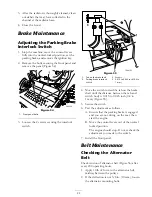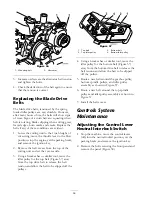
Battery terminals or metal tools could short
against metal machine components causing
sparks. Sparks can cause the battery gasses
to explode, resulting in personal injury.
•
When removing or installing the battery,
do not allow the battery terminals to
touch any metal parts of the machine.
•
Do not allow metal tools to short between
the battery terminals and metal parts of
the machine.
Incorrect battery cable routing could
damage the machine and cables causing
sparks. Sparks can cause the battery gasses
to explode, resulting in personal injury.
•
Always disconnect the negative (black)
battery cable before disconnecting the
positive (red) cable.
•
Always connect the positive (red) battery
cable before connecting the negative
(black) cable.
Storing the Battery
If the machine will be stored more than 30 days,
remove the battery and charge it fully. Either
store it on a shelf or on the machine. Leave the
cables disconnected if it is stored on the machine.
Store the battery in a cool atmosphere to avoid
quick deterioration of the charge in the battery.
To prevent the battery from freezing, make sure
it is fully charged. The specific gravity of a fully
charged battery is 1.265-1.299.
Checking the Fuses
The fuses are located under the control panel.
Access them through the side panel cover
(Figure 49). To open the side panel cover, release
the 2 latches and pull out on it.
If the machine stops or has other electrical system
issues, check the fuses. Grasp each fuse in turn
and remove them one at a time, checking to see
if any are blown. If you need to replace a fuse,
always use the
same type and amperage rated
fuse
as the one you are replacing,
otherwise you
could damage the electrical system
(refer to the
decal next to the fuses (Figure 50) for a diagram
of each fuse and its amperage).
Note:
If a fuse blows frequently, you probably
have a short in the electrical system and should
have it serviced by a qualified service technician.
Figure 49
1. Side panel cover
2. Latches
Figure 50
Drive System
Maintenance
Checking the Tire Pressure
Check the pressure after every 50 operating hours
or monthly, whichever occurs first (Figure 51).
52
Summary of Contents for Groundsmaster 7200 Series
Page 9: ...Slope Chart 9 ...
Page 44: ...Figure 39 44 ...
Page 70: ...Schematics Electrical Schematic Rev A 70 ...
Page 71: ...Hydraulic Schematic Rev A 71 ...
















































